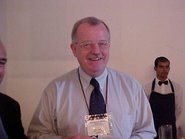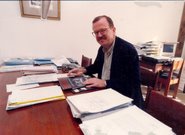In the sixties the concept of ecology emerged. UNESCO started its program Man & Biosphere and IUCN its Commission on Ecology. Ecology, the inter-connectedness in nature and the role and impact of the human species meant for EduC meant a further broadening of its scope. Conceptually it meant the start of seeing conservation education – with a focus on building capacities for free and informed choices – as different from the technical paradigms of conservation itself.




 Lev Shaposhnikov, Don Aldridge, Pierre Goeldin, Jan Čeřovský, Report on Nature Conservation in Eastern Europe.
Lev Shaposhnikov, Don Aldridge, Pierre Goeldin, Jan Čeřovský, Report on Nature Conservation in Eastern Europe.In 1968 UNESCO convened the World Biosphere Conference of governmental experts in Paris, starting the global “first environmental wave”. The Conference was divided into three commissions, among them one on education chaired by Jan Čeřovský with secretarial assistance by the Venezuelan Gerardo Budowski (later the first Director General of IUCN). The result was the first international elaboration of the concept of environmental education. The IUCN EduC played an important role in the Conference, although it was still relatively small and consisted mostly of biologists from Europe and North America with an affinity for education.
From the mid fifties and throughout most of the sixties Johannes Goudswaard (Netherlands) started to serve the Commission as Honorary Secretary, in a voluntary capacity. In the late sixties Jan Čeřovský (Czechoslovakia, 1930) was appointed as the first education officer in the Secretariat, a position he held until the early seventies. The IUCN General Assembly in Poland 1960 adopted an EduC initiated recommendation to start establishing regional committees of commissions. In the early sixties the North West European Committee for Environmental Education (NWEC) was formed with the formed with the Norwegian Professor Ove Arbo Høeg as the first Chairman. Following its example, the East European Committee (EEC) was established in 1967 with Professor Tadeusz Szczecny of Poland as the first Chair and Mária Lexová from Czechoslovakia as Secretary. The uniqueness of this Committee was its lengthy position as the first and only internationally instituted conservation body eastwards of the “iron curtain”. For example, EEC and IYF arranged in 1969 the youth international camp in the Khoper Nature Reserve (south-east of European Russia). Between the late sixties and early seventies regional committees of EduC were established in India, North America and South Africa and French speaking West Africa: unfortunately, they were only short-lived ones.

 Left: The establishing conference of the East European Committee, Praha, Czech Republic, September 1967. From left to right: Thomas Pritchard (EduC Deputy Chair), Lev K. Shaposhnikov (EduC Chair), Vladimir Novotny (Director, Czech Institute for Protection of Monuments and Nature), Jan Cerovsky (EduC Deputy Chair), Frantisek Tepper (Head, Department of the Czech Ministry for Culture), Joseph Berwick (IUCN Secretary General), interpreter. - Photo Archive, Czech Agency for Nature Conservation and Landscape Protection. Right: Break during the meeting of NWEC, Germany, May 1967. From left to right: Martha ("Muffy") Henderson (USA, later the second wife of Harold J. Coolidge, IUCN President 1966-1972), Jan-Piet Doets (The Netherlands), Thomas Pritchard (UK). - Photo Jan Cerovsky's archive.
Left: The establishing conference of the East European Committee, Praha, Czech Republic, September 1967. From left to right: Thomas Pritchard (EduC Deputy Chair), Lev K. Shaposhnikov (EduC Chair), Vladimir Novotny (Director, Czech Institute for Protection of Monuments and Nature), Jan Cerovsky (EduC Deputy Chair), Frantisek Tepper (Head, Department of the Czech Ministry for Culture), Joseph Berwick (IUCN Secretary General), interpreter. - Photo Archive, Czech Agency for Nature Conservation and Landscape Protection. Right: Break during the meeting of NWEC, Germany, May 1967. From left to right: Martha ("Muffy") Henderson (USA, later the second wife of Harold J. Coolidge, IUCN President 1966-1972), Jan-Piet Doets (The Netherlands), Thomas Pritchard (UK). - Photo Jan Cerovsky's archive.









No comments:
Post a Comment